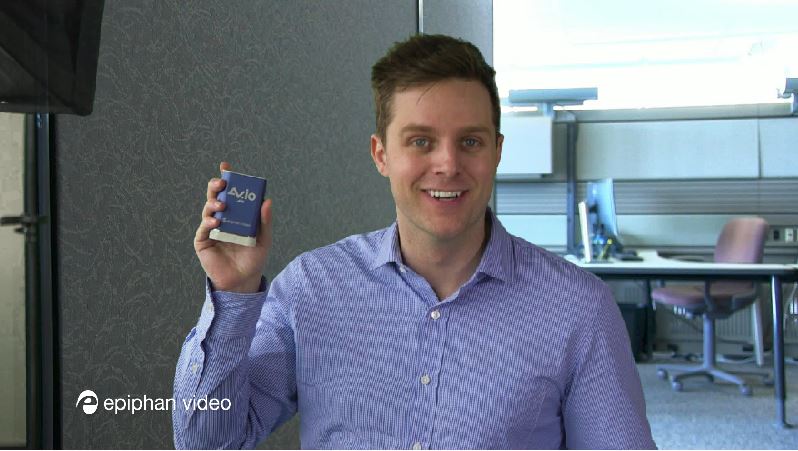Configure chroma keying
Add special effects to any video source in a custom channel with chroma keying. Add great looking effects such as animated lower thirds using a titler software or add a custom background using green screen. It's easy to get creative.
With chroma keying, you can choose a specific color in your video scene and replace everything of that color with a different image or video.
The most common color used for chroma keying is green. In this example, the original video source shows someone standing in front of a green screen. Using chroma key, an image of an office space replaces the green background.


White, grey, and black are not recommended colors for chroma keying. Those are treated as the same color with a different luminance value. The result is that the chroma keying affect gets applied to all shades ranging from white to black.
You configure chroma keying using the custom layout editor, see About the custom layout editor.
Topics include:
- Performance considerations
- What is upstream chroma keying?
- What is downstream chroma keying?
- Set up chroma key for a green screen video source
- Add external titler software effects to Pearl-2
- Add chroma key titler effects using Microsoft Powerpoint slides
Chroma keying can impact performance depending on how many chroma key sources you add, if you scale the chroma key video source using the custom layout editor, and your frame rate.
For best performance, avoid excessive scaling of video sources that have chroma keying enabled. Cropping video sources that have chroma keying enabled helps reduce processing and optimizes the performance.
You can monitor performance from the Info tab using the Admin panel for the custom channel that has chroma keying enabled.
Observe the following:
- The maximum resolution is 1920×1080 at 30 fps for chroma keying.
- Avoid scaling a video source that has chroma key enabled.
- Where possible, crop the video source that has the chroma key enabled to minimize the area to process for the chroma key effect.
- Overloading the processor can cause frame drops.
What is upstream chroma keying?
Upstream chroma keying applies the chroma key effect to a specific video source before it's processed, switched, and broadcast.
For example, you could display the name of a guest using titler software on only the camera that is dedicated for close ups of that person but not on any of your other video sources.

To get an upstream key effect, create custom layouts for each video source using the custom layout editor. Then set up chroma keying on just one custom layout. Only the video source that appears in the custom layout with chroma key enabled has the chroma key effect applied to it.
To apply the chroma key effect to a video source that appears in several different custom layouts, enable the chroma key effect in each custom layout where that particular video source appears.
What is downstream chroma keying?
Downstream chroma keying applies the chroma key effect to all video sources you broadcast after they're processed and switched.
A common use of downstream keying is to display a persistent image, like a company logo, so that it always appears on screen.

To get a downstream key effect, enable the same chroma key effect on all your custom layouts. This way, the same chroma key effect gets applied to everything you stream or record.

